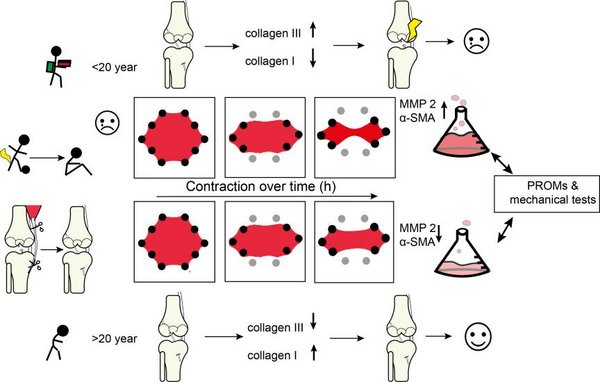
Background
After an anterior cruciate ligament rupture, a reconstruction is often a prerequisite, since the ACL itself does not heal upon rupture. This is in order to bring back stability in the knee, to fully participate in sports and work, and to prevent osteoarthritis. Hamstring tendon autografts are the golden standard for anterior cruciate ligament reconstruction, which have a rerupture rate of 0.7% to 10%. This rate increases in younger people (under twenty years) to up to 30%. However, the reason for the age-related discrepancy remains unknown.
Goal
The aim of this research was to measure various tissue remodeling-related biological properties in human hamstring tendon-derived cells, by making use of an in vitro microtissue platform, in order to identify parameters which could indeed be responsible for the high rerupture rate among young people.
Method
Human hamstring tendon-derived cells, obtained from material left-over from ACL reconstructive surgery, were seeded in microtissues, and by measuring contraction over time, performing semi-quantitative analysis for alpha-smooth muscle actin, tenomodulin, and matrix metalloprotease 2 expression, differences between patient cells were explored. Outcomes were correlated to age, to check if a biological parameter exists which could be responsible for the high rerupture rate among young people.
Results
Human hamstring tendon-derived cells from thirteen different patients were assessed, of which the younger patients aged eleven and twelve, and one patient twenty-four years of age, displayed a faster contraction (compared to the other samples) in the microtissue platform. Differences in the expression of alpha-smooth muscle actin were found, but did not necessarily correlate to age. Tenomodulin was only detected in samples from two patients, respectively twenty-two and thirty-one years old. Total matrix metalloprotease 2 expression varied between patients, however no significant difference in the active fraction was found.
Discussion & Conclusion
The microtissue platform was capable of assessing remodeling-related biological differences, but no direct correlation of one of the parameters to age was found. A higher sample size is required to look into the correlation to age with certainty.
Future outlook
In the near future, clinical patient outcomes will become available and will be compared to the data obtained in this study, since the parameters measured could be linked to graft weakening or laxity. Results obtained from this in vitro platform could be a predictive tool to identify patients at risk for a rerupture and can present opportunities for more patient-specific rehabilitation.